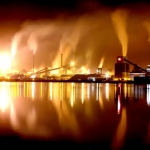WORLD: Buyers unravel the ethics behind the label
If you ever buy an item of clothing from Tesco, the UK supermarket chain, you can be sure it will not contain any cotton from Uzbekistan. The company decided to boycott Uzbek cotton in 2006, following reports of forced and state-sanctioned child labour. That was the easy part. Eliminating the unwanted material from Tesco's supply chain and proving that it was no longer used would take until the end of 2007.
"It was an enormously complex task," says Alan Wragg, the company's clothing technical director. "Even the production of a simple garment such as a T-shirt requires materials to pass through four to seven pairs of hands, so the number of possible permutations in the supply chain was huge."
Traceability has become an especially pressing issue for the clothing industry in recent years, as stories of worker exploitation have emerged from the developing world. However, some supply chain experts believe all retailers and their suppliers should be preparing for the sorts of challenges faced by Mr Wragg. We are approaching a tipping point, they say, beyond which everyone will want to know the provenance of their products.
In May, the Global Reporting Initiative, a network of 20,000 organisations developing a framework for corporate sustainability reporting, published "The Transparent Economy", a report that identified traceability as a key challenge in corporate reporting over the next decade. It also included a survey in which 86 per cent of GRI members rated "the importance of the ability of businesses to trace products through their entire life cycle" as important or very important.
The report's lead author was John Elkington, the corporate responsibility and sustainable development expert who coined the term "triple bottom line". He points out that the food and pharmaceuticals sectors have led the way on supply chain traceability because their products have such a quick and dramatic impact on public health. However, he says, it is the growing interest of supermarkets in traceability that will turn it from a minor activity into a common practice.
"The supermarkets, in the end, are often the market gatekeepers and choice editors," he says. "When we did books like The Green Consumer Guide [a 1988 bestseller on how to make purchasing decisions that would help the environment], most supermarkets were disinterested ... until their customers started expressing preferences. Then things changed very quickly indeed."
Ethical spending has grown significantly over the past two decades, in line with increased amounts of information on corporate activities entering the public domain. In the UK, for example, the amount of spending and investment influenced by ethical considerations almost doubled between 1999 and 2008 to reach £36bn, according to research by the Co-operative Bank and the Ethical Consumer Research Association. Accordingly, supermarkets have stocked more products that use ethical standards in their marketing, such as foods certified as organic or Fairtrade.
Now, Mr Elkington and others say, they and their big suppliers are becoming more proactive.
"Some companies, such as Nike, have been blending increasing amounts of organic cotton into apparel that is mainly non-organic to 'walk the market up' at an achievable pace," he says. "We are also seeing areas such as Fairtrade scaling up very rapidly now, as the giants - the likes of Kraft and Nestlé - wade in. Policing of claims becomes much more important in such circumstances."
At Tesco, Mr Wragg knew that in order to monitor his supply chain, he first needed to see it more clearly. "We learnt quickly that our supply chain was very complicated and diverse," he says. "We knew that Uzbek cotton was taken mainly to Bangladesh, Turkey and China, but most producers of yarn don't use a single source, they blend cotton from a variety of countries." The quality of raw cotton can vary depending on local factors such as weather conditions, he explains, so blending prevents inconsistencies in the finished yarn.
The solution was provided by Historic Futures. This UK company has developed an online application called String, which enables users to see at a glance what has happened to a particular product at every stage in its supply chain. String can capture data about any event resulting in an output - for example, when raw materials are purchased from a third party, when production processes are performed on those materials and so on - including documentary evidence uploaded to the site. If anyone fails to provide such evidence, this is clearly visible to those further along the supply chain.
"We're not in the business of guaranteeing the data, we're in the business of automating the audit process," says Tim Wilson, managing director. However, he says, it would be difficult for a user to falsify information and get away with it because the system allows for easy cross-referencing.
"If you wanted to falsify your data, then you'd have to get everyone below you in the chain to falsify their data too. It's a tiny problem compared with the patchy recording of data, which is already commonplace where no such system exists. We want String to be the Facebook of supply chains."
String is free to use if you simply want to provide information to a client who uses the system. If you want to request information from other String users, you pay a subscription fee, which varies depending on features and usage levels. Since the company was founded in 2003, it has delivered pilot projects and regional implementations for brands such as Walmart, Levi's and Gap.
There are many other types of software designed to track supply chain data - most big suppliers of enterprise software, for example, offer supply chain management modules - but these are geared towards providing management intelligence. Where such data are made available to the public proactively as an aid to purchasing decisions, it is generally in basic form and needs only a simple database system accessible via the web.
The food company Dole, for example, labels each of its organic bananas with a three-digit number that, when entered into its website, reveals details of the farm where that banana was grown. In New Zealand, the clothing manufacturer Icebreaker uses a similar system to give customers multimedia information about where the wool in their garments was sourced.
String, by contrast, can be configured to show the customer much of what the company sees. When buyers of LoveEarth jewellery, sold by Walmart, enter a label number into the relevant website, they can see which materials were handled by which companies at every stage of the production process.
Critics point out that such systems do not in themselves guarantee ethical behaviour. "Supply chain auditing is currently a necessary but not sufficient tool to deliver assurance on labour standards," says Rachel Wilshaw, ethical trade manager at Oxfam, the development charity, which advises companies on how to trade more ethically. "Commercial audits in particular have delivered limited change for workers, added significant cost to the supply chain and, increasingly, do not provide reliable assurance about standards because of growing audit fraud."
Advocates counter that supply chain transparency should, in itself, make it easier for independent observers to police standards and for consumers to make informed decisions. If a consumer wishes to boycott LoveÂEarth jewellery because, say, a mining company they dislike is involved, then that is their prerogative. Previously, they would never have known how that jewellery got from "mine to market".



